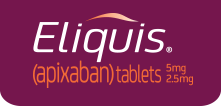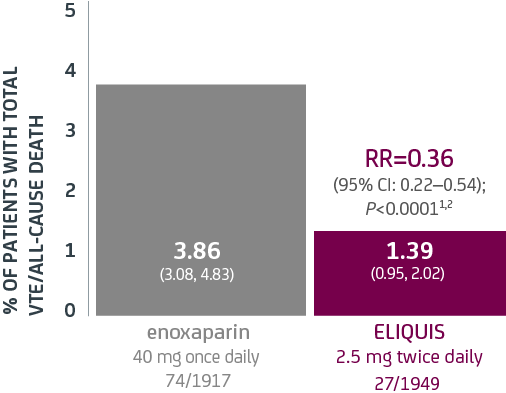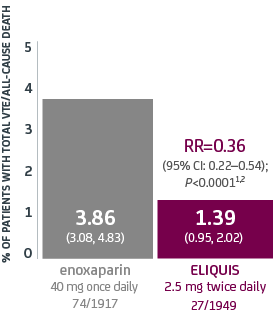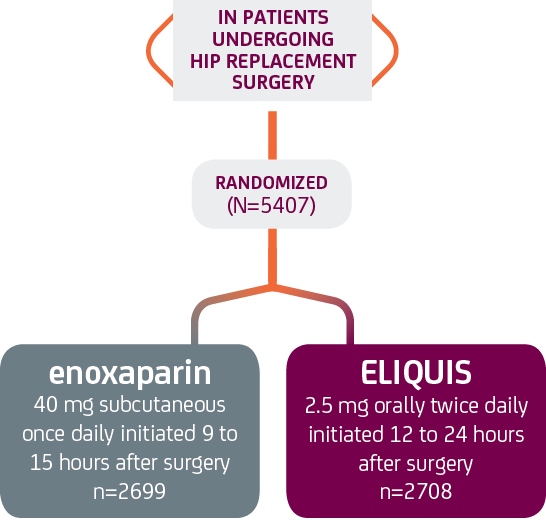- 1
- 2
- 3
ELIQUIS is indicated to reduce the risk of stroke and systemic embolism in adult patients with nonvalvular atrial fibrillation (NVAF).
Eliquis indicated for the treatment of adults with deep vein thrombosis (DVT) and pulmonary embolism (PE), and to reduce the risk of recurrent DVT and PE following initial therapy.
Eliquis is indicated for the prophylaxis of deep vein thrombosis (DVT), which may lead to pulmonary embolism (PE), in adult patients who have undergone hip or knee replacement surgery.


U.S. FULL PRESCRIBING INFORMATION, including Boxed WARNINGS
Please verify that you are a U.S. Healthcare Professional
U.S. FULL PRESCRIBING INFORMATION, including Boxed WARNINGS
Please verify that you are a U.S. Healthcare Professional
Leaving hcp.eliquis.com
XYou are about to leave the Bristol Myers Squibb and Pfizer hcp.eliquis.com site. You are being redirected to a Bristol Myers Squibb corporate site.
Would you like to leave this site?
Leaving hcp.eliquis.com X
You are about to leave the Bristol Myers Squibb and Pfizer hcp.eliquis.com site. Bristol Myers Squibb and Pfizer are not responsible for the content of such other sites. Links to other sites are provided only as a convenience to users of this site.
Would you like to leave this site?
Leaving hcp.eliquis.com X
You are about to leave the Bristol Myers Squibb and Pfizer hcp.eliquis.com site. You are being redirected to a Pfizer corporate site.
Would you like to leave this site?
Leaving hcp.eliquis.com X
You are about to leave the Bristol Myers Squibb and Pfizer hcp.eliquis.com site. You are being redirected to an external site for information on ELIQUIS® (apixaban) samples.
Would you like to leave this site?
Contact us
XFor your convenience, specialized Bristol Myers Squibb representatives are available by phone or email to help you with your medical, technical, or general inquiries.
General and technical inquiries
(877) 517-6326 (Monday–Friday, 8 AM–8 PM ET)
Adverse event or product quality complaints
Medical information inquiries
BMSMedInfo.com to search online or email your inquiry (login or registration required)
(800) 321-1335 (Monday–Friday, 8 AM–5 PM ET)
432-US-2300211 06/23
Select document to view or download
XIf you need Adobe® Reader®, click the link below to download the free reader.
Link to Adobe Reader download pageSelect document to view or download
XIf you need Adobe® Reader®, click the link below to download the free reader.
Link to Adobe Reader download pageChoose ELIQUIS for the prophylaxis of deep vein thrombosis (DVT), which may lead to pulmonary embolism (PE), after hip or knee replacement surgery
Total VTE*/All-cause death†


PRIMARY EFFICACY ENDPOINT
CI=confidence interval; RR=relative risk; VTE=venous thromboembolism.
*Total VTE includes symptomatic and asymptomatic DVT and PE.
†Bleeding events associated with each endpoint were counted once per subject, but subjects may have contributed events to multiple endpoints
Safety endpoints of ELIQUIS vs enoxaparin for hip replacement surgery patients1,2
Bleeding events (including surgical site)


SAFETY ENDPOINTS
Representation of bleeding endpoints does not imply statistical significance.
‡Includes 13 subjects with major bleeding events that occurred before the first dose of ELIQUIS (administered 12–24 hours post-surgery).
CRNM=clinically relevant nonmajor.
ELIQUIS increases the risk of bleeding and can cause serious, potentially fatal, bleeding.1
Adverse reactions occurring in ≥1% of patients undergoing hip or knee replacement surgery in the 3 phase III studies (ADVANCE trials) and 1 phase II study1
| NUMBER OF PATIENTS (%) | ||
|---|---|---|
|
enoxaparin 40 mg sc qd or 30 mg sc q12h n=5904 |
ELIQUIS 2.5 mg po bid n=5924 |
|
| Nausea | 159 (2.7) | 153 (2.6) |
| Anemia (including postoperative and hemorrhagic anemia, and respective laboratory parameters) | 178 (3.0) | 153 (2.6) |
| Contusion | 115 (1.9) | 83 (1.4) |
| Hemorrhage (including hematoma, and vaginal and urethral hemorrhage) | 81 (1.4) | 67 (1.1) |
| Postprocedural hemorrhage (including postprocedural hematoma, wound hemorrhage, vessel puncture site hematoma, and catheter site hemorrhage) | 60 (1.0) | 54 (0.9) |
| Transaminases increased (including alanine aminotransferase increased and alanine aminotransferase abnormal) | 71 (1.2) | 50 (0.8) |
| Aspartate aminotransferase increased | 69 (1.2) | 47 (0.8) |
| Gamma-glutamyltransferase increased | 65 (1.1) | 38 (0.6) |
Representation of bleeding endpoints does not imply statistical significance.
ADVANCE-3 Study Design
A randomized, double-blind phase III clinical trial to compare the efficacy and safety of ELIQUIS vs enoxaparin for prophylaxis of deep vein thrombosis following surgery in 5407 patients undergoing elective hip replacement surgery. 2708 patients were randomized to receive ELIQUIS 2.5 mg orally twice daily, and 2699 patients were randomized to enoxaparin 40 mg subcutaneously once daily. Treatment duration was 32 to 38 days for each group. The primary efficacy endpoint§|| was total VTE¶ or all-cause death, and the safety endpoints were major bleeding, major plus clinically relevant nonmajor# bleeding, and all bleeding.1,2
§A composite of adjudicated asymptomatic and symptomatic DVT, nonfatal pulmonary embolism (PE), and all-cause death at the end of the double-blind intended treatment period.
||The primary endpoint was tested for noninferiority, then superiority, of ELIQUIS to enoxaparin.
¶Total VTE includes symptomatic and asymptomatic DVT and PE.
#Clinically relevant nonmajor bleeding included acute, clinically overt episodes such as wound hematoma, bruising, or ecchymosis, gastrointestinal bleeding, hemoptysis, hematuria, or epistaxis that did not meet the criteria for major bleeding.
Major bleeding was defined as acute, clinically overt bleeding accompanied by 1 or more of the following2: a decrease in hemoglobin (Hgb) ≥2 g/dL over a 24-hour period; transfusion of 2 or more units of packed red cells; bleeding at a critical site (ie, intracranial, intraspinal, intraocular, pericardial, an operated joint requiring reoperation or intervention, intramuscular with compartment syndrome, retroperitoneal bleeding); or fatal bleeding.
ADVANCE-3: a randomized, multicenter, double-blind, double-dummy, phase III trial1,2
Study objective: To compare the effectiveness of ELIQUIS 2.5 mg twice daily to enoxaparin 40 mg once daily for the prophylaxis of DVT following hip replacement surgery.

 Treatment duration:
Treatment duration:35 days (range: 32 to 38 days)
-
Primary efficacy endpoint*: Total
VTE or all-cause death
- The primary outcome was tested for noninferiority, then superiority, of ELIQUIS to enoxaparin
-
Safety endpoints:
Major bleeding†
Major + clinically relevant nonmajor‡ bleeding
All bleeding
Major inclusion criteria: Patients scheduled for elective total hip replacement or revision of a previously inserted hip prosthesis.
Major exclusion criteria: Active bleeding, a contraindication to anticoagulant prophylaxis, or the need for ongoing anticoagulant or antiplatelet treatment.
Baseline characteristics: The 2 treatment groups were well balanced with respect to baseline characteristics, including mean age, mean weight, and mean body mass index (BMI).
Baseline characteristics of randomized patients in the ELIQUIS and enoxaparin treatment groups in ADVANCE-32
| enoxaparin n=2699 |
ELIQUIS n=2708 |
|
|---|---|---|
| Mean age, years | 60.6 | 60.9 |
| Mean weight, kg | 79.5 | 79.9 |
| Mean BMI, kg/m2 | 28.1 | 28.2 |
| Estimated CrCl >60 mL/min, no. (%) | 2376 (88.0) | 2381 (87.9) |
CrCl=creatinine clearance; VTE=venous thromboembolism.
*A composite of adjudicated asymptomatic and symptomatic DVT, nonfatal PE, and all-cause death at the end of the double-blind intended treatment period.
†Major bleeding was defined as acute, clinically overt bleeding accompanied by 1 or more of the following2:
- A decrease in hemoglobin of 2 g/dL or more over a 24-hour period
- A transfusion of 2 or more units of packed red blood cells
- Bleeding that occurred in at least 1 of the following critical sites: intracranial, intraspinal, intraocular, pericardial, an operated joint requiring reoperation or intervention, intramuscular with compartment syndrome, and retroperitoneal
- Fatal bleeding
‡Clinically relevant nonmajor bleeding included acute, clinically overt episodes such as wound hematoma, bruising, or ecchymosis, gastrointestinal bleeding, hemoptysis, hematuria, or epistaxis that did not meet the criteria for major bleeding.
Total VTE*/All-cause death†


PRIMARY EFFICACY ENDPOINT
CI=confidence interval; RR=relative risk; VTE=venous thromboembolism.
*Total VTE includes symptomatic and asymptomatic DVT and PE.
†Bleeding events associated with each endpoint were counted once per subject, but subjects may have contributed events to multiple endpoints
Bleeding endpoints of ELIQUIS vs enoxaparin for knee replacement surgery patients1,3
Bleeding events (including surgical site)


SAFETY ENDPOINTS
Representation of bleeding endpoints does not imply statistical significance.
‡Includes 5 subjects with major bleeding events that occurred before the first dose of ELIQUIS (administered 12-24 hours post-surgery).
CRNM=clinically relevant nonmajor.
ELIQUIS increases the risk of bleeding and can cause serious, potentially fatal, bleeding.1
Adverse reactions occurring in ≥1% of patients undergoing hip or knee replacement surgery in the 3 phase III studies (ADVANCE trials) and 1 phase II study1
| Number of patients (%) | ||
|---|---|---|
|
enoxaparin 40 mg sc qd or 30 mg sc q12h n=5904 |
ELIQUIS 2.5 mg po bid n=5924 |
|
| Nausea | 159 (2.7) | 153 (2.6) |
| Anemia (including postoperative and hemorrhagic anemia, and respective laboratory parameters) | 178 (3.0) | 153 (2.6) |
| Contusion | 115 (1.9) | 83 (1.4) |
| Hemorrhage (including hematoma, and vaginal and urethral hemorrhage) | 81 (1.4) | 67 (1.1) |
| Postprocedural hemorrhage (including postprocedural hematoma, wound hemorrhage, vessel puncture site hematoma, and catheter site hemorrhage) | 60 (1.0) | 54 (0.9) |
| Transaminases increased (including alanine aminotransferase increased and alanine aminotransferase abnormal) | 71 (1.2) | 50 (0.8) |
| Aspartate aminotransferase increased | 69 (1.2) | 47 (0.8) |
| Gamma-glutamyltransferase increased | 65 (1.1) | 38 (0.6) |
Representation of bleeding endpoints does not imply statistical significance.
ADVANCE-2 Study Design
A randomized, double-blind phase III clinical trial to compare the efficacy and safety of ELIQUIS vs enoxaparin for prophylaxis of deep vein thrombosis following surgery in 3057 patients undergoing elective knee replacement surgery. 1528 patients were randomized to receive ELIQUIS 2.5 mg orally twice daily, and 1529 patients were randomized to enoxaparin 40 mg subcutaneously once daily. Treatment duration was 10 to 14 days for each group. The primary efficacy endpoint§|| was total VTE¶ or all-cause death, and the safety endpoints were major bleeding, major plus clinically relevant nonmajor# bleeding, and all bleeding.1,3
§A composite of adjudicated asymptomatic and symptomatic DVT, nonfatal pulmonary embolism (PE), and all-cause death at the end of the double-blind intended treatment period.
||The primary endpoint was tested for noninferiority, then superiority, of ELIQUIS to enoxaparin.
¶Total VTE includes symptomatic and asymptomatic DVT and PE.
#Clinically relevant nonmajor bleeding included acute, clinically overt episodes such as wound hematoma, bruising, or ecchymosis, gastrointestinal bleeding, hemoptysis, hematuria, or epistaxis that did not meet the criteria for major bleeding.
Major bleeding was defined as acute, clinically overt bleeding accompanied by 1 or more of the following3: a decrease in hemoglobin (Hgb) ≥2 g/dL over a 24-hour period; transfusion of 2 or more units of packed red cells; bleeding at a critical site (ie, intracranial, intraspinal, intraocular, pericardial, an operated joint requiring reoperation or intervention, intramuscular with compartment syndrome, retroperitoneal bleeding); or fatal bleeding.
ADVANCE-2: a randomized, multicenter, double-blind, double-dummy, phase III trial1,3
Study objective: To compare the effectiveness of ELIQUIS 2.5 mg twice daily to enoxaparin 40 mg once daily for the prophylaxis of DVT following knee replacement surgery.


-
Primary efficacy endpoint*: Total
VTE or all-cause death
- The primary outcome was tested for noninferiority, then superiority, of ELIQUIS to enoxaparin
-
Safety endpoints:
Major bleeding†
Major + clinically relevant nonmajor‡ bleeding
All bleeding
Major inclusion criteria: Patients scheduled to have unilateral elective total knee replacement or same-day bilateral knee replacement, including revision of a previously inserted artificial joint.
Major exclusion criteria: Active bleeding, a contraindication to anticoagulant prophylaxis, or the need for ongoing anticoagulant or antiplatelet treatment.
Baseline characteristics: The 2 treatment groups were well balanced with respect to baseline characteristics, including mean age, mean weight, and mean body mass index (BMI).
Baseline characteristics of randomized patients in the ELIQUIS and enoxaparin treatment groups in ADVANCE-23
| enoxaparin n=1529 |
ELIQUIS n=1528 |
|
|---|---|---|
| Mean age, years | 67 | 67 |
| Mean weight, kg | 78 | 78 |
| Mean BMI, kg/m2 | 29.3 | 29.1 |
| Estimated CrCl >60 mL/min, no. (%) | 1291 (84.0) | 1258 (82) |
CrCl=creatinine clearance; VTE=venous thromboembolism.
*A composite of adjudicated asymptomatic and symptomatic DVT, nonfatal PE, and all-cause death at the end of the double-blind intended treatment period.
†Major bleeding was defined as acute, clinically overt bleeding accompanied by 1 or more of the following3:
- A decrease in hemoglobin of 2 g/dL or more over a 24-hour period
- A transfusion of 2 or more units of packed red blood cells
- Bleeding that occurred in at least 1 of the following critical sites: intracranial, intraspinal, intraocular, pericardial, an operated joint requiring reoperation or intervention, intramuscular with compartment syndrome, and retroperitoneal
- Fatal bleeding
‡Clinically relevant nonmajor bleeding included acute, clinically overt episodes such as wound hematoma, bruising, or ecchymosis, gastrointestinal bleeding, hemoptysis, hematuria, or epistaxis that did not meet the criteria for major bleeding.
Total VTE*/All-cause death†


PRIMARY EFFICACY ENDPOINT
CI=confidence interval; NS=nonsignificant; RR=relative risk; VTE=venous thromboembolism.
*Total VTE includes symptomatic and asymptomatic DVT and PE.
†Bleeding events associated with each endpoint were counted once per subject, but subjects may have contributed events to multiple endpoints.
Bleeding endpoints of ELIQUIS vs enoxaparin for knee replacement surgery patients1,4
Bleeding events (including surgical site)


SAFETY ENDPOINTS
Representation of bleeding endpoints does not imply statistical significance.
CRNM=clinically relevant nonmajor.
ELIQUIS increases the risk of bleeding and can cause serious, potentially fatal, bleeding.1
Adverse reactions occurring in ≥1% of patients undergoing hip or knee replacement surgery in the 3 phase III studies (ADVANCE trials) and 1 phase II study1
| Number of patients (%) | ||
|---|---|---|
|
enoxaparin 40 mg sc qd or 30 mg sc q12h n=5904 |
ELIQUIS 2.5 mg po bid n=5924 |
|
| Nausea | 159 (2.7) | 153 (2.6) |
| Anemia (including postoperative and hemorrhagic anemia, and respective laboratory parameters) | 178 (3.0) | 153 (2.6) |
| Contusion | 115 (1.9) | 83 (1.4) |
| Hemorrhage (including hematoma, and vaginal and urethral hemorrhage) | 81 (1.4) | 67 (1.1) |
| Postprocedural hemorrhage (including postprocedural hematoma, wound hemorrhage, vessel puncture site hematoma, and catheter site hemorrhage) | 60 (1.0) | 54 (0.9) |
| Transaminases increased (including alanine aminotransferase increased and alanine aminotransferase abnormal) | 71 (1.2) | 50 (0.8) |
| Aspartate aminotransferase increased | 69 (1.2) | 47 (0.8) |
| Gamma-glutamyltransferase increased | 65 (1.1) | 38 (0.6) |
Representation of bleeding endpoints does not imply statistical significance.
ELIQUIS increases the risk of bleeding and can cause serious, potentially fatal, bleeding.1
ADVANCE-1 Study Design
A randomized, double-blind phase III clinical trial to compare the efficacy and safety of ELIQUIS vs enoxaparin for prophylaxis of deep vein thrombosis following surgery in 3195 patients undergoing elective knee replacement surgery. 1599 patients were randomized to receive ELIQUIS 2.5 mg orally twice daily, and 1596 patients were randomized to enoxaparin 30 mg subcutaneously twice daily. Treatment duration was 10 to 14 days for each group. The primary efficacy endpoint‡§ was total VTE|| or all-cause death, and the safety endpoints were major bleeding, major plus clinically relevant nonmajor¶ bleeding, and all bleeding.1,4
‡A composite of adjudicated asymptomatic and symptomatic DVT, nonfatal pulmonary embolism (PE), and all-cause death at the end of the double-blind intended treatment period.
§The primary endpoint was tested for noninferiority of ELIQUIS to enoxaparin.
||Total VTE includes symptomatic and asymptomatic DVT and PE.
¶Clinically relevant nonmajor bleeding included acute, clinically overt episodes such as wound hematoma, bruising, or ecchymosis, gastrointestinal bleeding, hemoptysis, hematuria, or epistaxis that did not meet the criteria for major bleeding.
Major bleeding was defined as acute, clinically overt bleeding accompanied by 1 or more of the following4: a decrease in hemoglobin (Hgb) ≥2 g/dL over a 24-hour period; transfusion of 2 or more units of packed red cells; bleeding at a critical site (ie, intracranial, intraspinal, intraocular, pericardial, an operated joint requiring reoperation or intervention, intramuscular with compartment syndrome, retroperitoneal bleeding); or fatal bleeding.
ADVANCE-1: a randomized, multicenter, double-blind, double-dummy, phase III trial1,4
Study objective: To compare the effectiveness of ELIQUIS 2.5 mg twice daily to enoxaparin 30 mg twice daily for the prophylaxis of DVT following knee replacement surgery.

 Treatment duration:
Treatment duration:12 days (range: 10 to 14 days)
-
Primary efficacy endpoint*: Total
VTE or all-cause death
- The primary outcome was tested for noninferiority of ELIQUIS to enoxaparin1,4
-
Safety endpoints:
Major bleeding†
Major + clinically relevant nonmajor‡ bleeding
All bleeding
Major inclusion criteria: Patients scheduled to undergo total knee replacement surgery for one or both knees, including revision of a previously inserted artificial joint.
Major exclusion criteria: Active bleeding, a contraindication to anticoagulant prophylaxis, or the need for ongoing anticoagulant or antiplatelet treatment.
Baseline characteristics: The 2 treatment groups were well balanced with respect to baseline characteristics, including mean age, mean weight, and mean body mass index (BMI).
Baseline characteristics of randomized patients in the ELIQUIS and enoxaparin treatment groups in ADVANCE-14
| enoxaparin n=1596 |
ELIQUIS n=1599 |
|
|---|---|---|
| Mean age, years | 65.7 | 65.9 |
| Mean weight, kg | 86.7 | 86.7 |
| Mean BMI, kg/m2 | 31.1 | 31.2 |
| Estimated CrCl >60 mL/min, no. (%) | 1377 (86.3) | 1388 (86.8) |
CrCl=creatinine clearance; VTE=venous thromboembolism.
*A composite of adjudicated asymptomatic and symptomatic DVT, nonfatal PE, and all-cause death at the end of the double-blind intended treatment period.
†Major bleeding was defined as acute, clinically overt bleeding accompanied by 1 or more of the following4:
- A decrease in hemoglobin of 2 g/dL or more over a 24-hour period
- A transfusion of 2 or more units of packed red blood cells
- Bleeding that occurred in at least 1 of the following critical sites: intracranial, intraspinal, intraocular, pericardial, an operated joint requiring reoperation or intervention, intramuscular with compartment syndrome, and retroperitoneal
- Fatal bleeding
‡Clinically relevant nonmajor bleeding included acute, clinically overt episodes such as wound hematoma, bruising, or ecchymosis, gastrointestinal bleeding, hemoptysis, hematuria, or epistaxis that did not meet the criteria for major bleeding.
References
- ELIQUIS® (apixaban) Package Insert. Bristol-Myers Squibb Company, Princeton, NJ, and Pfizer Inc, New York, NY.
- Lassen MR, Gallus A, Raskob GE, Pineo G, Chen D, Ramirez LM, for the ADVANCE-3 Investigators. Apixaban versus enoxaparin for thromboprophylaxis after hip replacement. N Engl J Med. 2010;363(26):2487-2498.
- Lassen MR, Raskob GE, Gallus A, Pineo G, Chen D, Hornick P, and the ADVANCE-2 Investigators. Apixaban versus enoxaparin for thromboprophylaxis after knee replacement (ADVANCE-2): a randomized double-blind trial. Lancet. 2010;375(9717):807-815.
- Lassen MR, Raskob GE, Gallus A, Pineo G, Chen D, Portman RJ. Apixaban or enoxaparin for thromboprophylaxis after knee replacement. N Engl J Med. 2009;361(6):594-604.
WARNING: (A) PREMATURE DISCONTINUATION OF ELIQUIS INCREASES THE RISK OF THROMBOTIC EVENTS, (B) SPINAL/EPIDURAL HEMATOMA
(A) Premature discontinuation of any oral anticoagulant, including ELIQUIS® (apixaban), increases the risk of thrombotic events. If anticoagulation with ELIQUIS is discontinued for a reason other than pathological bleeding or completion of a course of therapy, consider coverage with another anticoagulant.
(B) Epidural or spinal hematomas may occur in patients treated with ELIQUIS who are receiving neuraxial anesthesia or undergoing spinal puncture. These hematomas may result in long-term or permanent paralysis. Consider these risks when scheduling patients for spinal procedures. Factors that can increase the risk of developing epidural or spinal hematomas in these patients include:
- use of indwelling epidural catheters
- concomitant use of other drugs that affect hemostasis, such as nonsteroidal anti-inflammatory drugs (NSAIDs), platelet inhibitors, other anticoagulants
- a history of traumatic or repeated epidural or spinal punctures
- a history of spinal deformity or spinal surgery
- optimal timing between the administration of ELIQUIS and neuraxial procedures is not known
Monitor patients frequently for signs and symptoms of neurological impairment. If neurological compromise is noted, urgent treatment is necessary.
Consider the benefits and risks before neuraxial intervention in patients anticoagulated or to be anticoagulated.
- Active pathological bleeding
- Severe hypersensitivity reaction to ELIQUIS (e.g., anaphylactic reactions)
- Increased Risk of Thrombotic Events after Premature Discontinuation: Premature discontinuation of any oral anticoagulant, including ELIQUIS, in the absence of adequate alternative anticoagulation increases the risk of thrombotic events. An increased rate of stroke was observed during the transition from ELIQUIS to warfarin in clinical trials in atrial fibrillation patients. If ELIQUIS is discontinued for a reason other than pathological bleeding or completion of a course of therapy, consider coverage with another anticoagulant.
- Bleeding Risk: ELIQUIS increases the risk of bleeding and can cause serious, potentially fatal, bleeding.
- Concomitant use of drugs affecting hemostasis increases the risk of bleeding, including aspirin and other antiplatelet agents, other anticoagulants, heparin, thrombolytic agents, SSRIs, SNRIs, and NSAIDs.
- Advise patients of signs and symptoms of blood loss and to report them immediately or go to an emergency room. Discontinue ELIQUIS in patients with active pathological hemorrhage.
- The anticoagulant effect of apixaban can be expected to persist for at least 24 hours after the last dose (i.e., about two half-lives). An agent to reverse the anti-factor Xa activity of apixaban is available for adults. Please visit www.andexxa.com for more information on availability of a reversal agent.
- Spinal/Epidural Anesthesia or Puncture: Patients treated with ELIQUIS undergoing spinal/epidural anesthesia or puncture may develop an epidural or spinal hematoma which can result in long-term or permanent paralysis. The risk of these events may be increased by the postoperative use of indwelling epidural catheters or the concomitant use of medicinal products affecting hemostasis. Indwelling epidural or intrathecal catheters should not be removed earlier than 24 hours after the last administration of ELIQUIS. The next dose of ELIQUIS should not be administered earlier than 5 hours after the removal of the catheter. The risk may also be increased by traumatic or repeated epidural or spinal puncture. If traumatic puncture occurs, delay the administration of ELIQUIS for 48 hours. Monitor patients frequently and if neurological compromise is noted, urgent diagnosis and treatment is necessary. Physicians should consider the potential benefit versus the risk of neuraxial intervention in ELIQUIS patients.
- Prosthetic Heart Valves: The safety and efficacy of ELIQUIS have not been studied in patients with prosthetic heart valves and is not recommended in these patients.
- Acute PE in Hemodynamically Unstable Patients or Patients who Require Thrombolysis or Pulmonary Embolectomy: Initiation of ELIQUIS is not recommended as an alternative to unfractionated heparin for the initial treatment of patients with PE who present with hemodynamic instability or who may receive thrombolysis or pulmonary embolectomy.
- Increased Risk of Thrombosis in Patients with Triple Positive Antiphospholipid Syndrome (APS): Direct-acting oral anticoagulants (DOACs), including ELIQUIS, are not recommended for use in patients with triple-positive APS. For patients with APS (especially those who are triple positive [positive for lupus anticoagulant, anticardiolipin, and anti–beta 2-glycoprotein I antibodies]), treatment with DOACs has been associated with increased rates of recurrent thrombotic events compared with vitamin K antagonist therapy.
- The most common and most serious adverse reactions reported with ELIQUIS were related to bleeding in adult patients.
- ELIQUIS should be discontinued at least 48 hours prior to elective surgery or invasive procedures with a moderate or high risk of unacceptable or clinically significant bleeding. ELIQUIS should be discontinued at least 24 hours prior to elective surgery or invasive procedures with a low risk of bleeding or where the bleeding would be noncritical in location and easily controlled. Bridging anticoagulation during the 24 to 48 hours after stopping ELIQUIS and prior to the intervention is not generally required. ELIQUIS should be restarted after the surgical or other procedures as soon as adequate hemostasis has been established.
- Combined P-gp and Strong CYP3A4 Inhibitors: Inhibitors of P-glycoprotein (P-gp) and cytochrome P450 3A4 (CYP3A4) increase exposure to apixaban and increase the risk of bleeding. For patients receiving ELIQUIS doses of 5 mg or 10 mg twice daily, reduce the dose of ELIQUIS by 50% when ELIQUIS is coadministered with drugs that are combined P-gp and strong CYP3A4 inhibitors (e.g., ketoconazole, itraconazole, or ritonavir). In patients already taking 2.5 mg twice daily, avoid coadministration of ELIQUIS with combined P-gp and strong CYP3A4 inhibitors. Clarithromycin Although clarithromycin is a combined P-gp and strong CYP3A4 inhibitor, pharmacokinetic data suggest that no dose adjustment is necessary with concomitant administration with ELIQUIS.
- Combined P-gp and Strong CYP3A4 Inducers: Avoid concomitant use of ELIQUIS with combined P-gp and strong CYP3A4 inducers (e.g., rifampin, carbamazepine, phenytoin, St. John’s wort) because such drugs will decrease exposure to apixaban.
- Anticoagulants and Antiplatelet Agents: Coadministration of antiplatelet agents, fibrinolytics, heparin, aspirin, and chronic NSAID use increases the risk of bleeding. APPRAISE-2, a placebo-controlled clinical trial of apixaban in high-risk post-acute coronary syndrome patients treated with aspirin or the combination of aspirin and clopidogrel, was terminated early due to a higher rate of bleeding with apixaban compared to placebo.
- The limited available data on ELIQUIS use in pregnant women are insufficient to inform drug-associated risks of major birth defects, miscarriage, or adverse developmental outcomes. Treatment may increase the risk of bleeding during pregnancy and delivery, and in the fetus and neonate.
- Labor or delivery: ELIQUIS use during labor or delivery in women who are receiving neuraxial anesthesia may result in epidural or spinal hematomas. Consider use of a shorter acting anticoagulant as delivery approaches.
- Breastfeeding is not recommended during treatment with ELIQUIS.
FEMALES AND MALES OF REPRODUCTIVE POTENTIAL
- Females of reproductive potential requiring anticoagulation should discuss pregnancy planning with their physician. The risk of clinically significant uterine bleeding, potentially requiring gynecological surgical interventions, identified with oral anticoagulants including ELIQUIS should be assessed in these patients and those with abnormal uterine bleeding.
ELIQUIS is indicated to reduce the risk of stroke and systemic embolism in adult patients with nonvalvular atrial fibrillation (NVAF).
ELIQUIS is indicated for the prophylaxis of deep vein thrombosis (DVT), which may lead to pulmonary embolism (PE), in adult patients who have undergone hip or knee replacement surgery.
ELIQUIS is indicated for the treatment of adults with DVT and PE, and to reduce the risk of recurrent DVT and PE following initial therapy.
Please see U.S. FULL PRESCRIBING INFORMATION, including Boxed WARNINGS, and MEDICATION GUIDE.
ELIQUIS is available in 2.5 mg and 5 mg tablets.

ELIQUIS® and the ELIQUIS logo are trademarks of Bristol-Myers Squibb Company.
All other trademarks are the property of their respective owners.
© 2025 Bristol-Myers Squibb Company. 432-US-2500240 07/25


